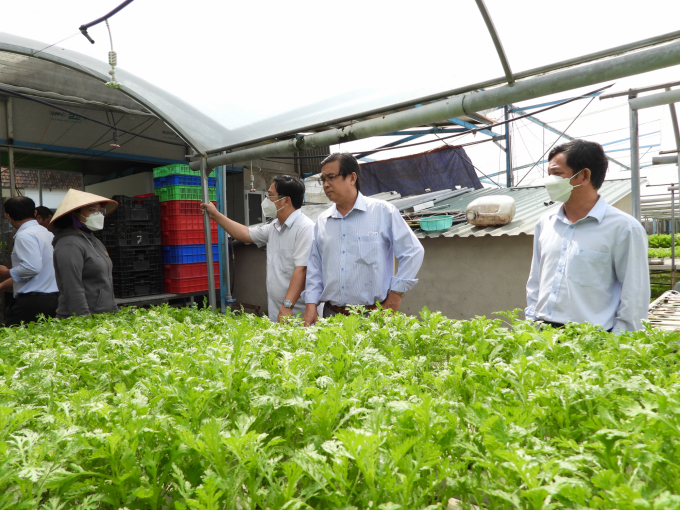Only grows vegetables but the “street farmer” who earns 150 million dong/month.
On average, each day, Mr. Chu Cao Tuan’s hydroponic vegetable garden in Trang Dai ward, Bien Hoa city (Dong
The delegation of the Agriculture Service Center of Dong Nai province surveyed Ms. Cao Diem Thuy's Farm Thermal hydroponic vegetable growing model. Photo: Tran Trung.
Located in the center of the vibrant city of Bien Hoa, Ms. Cao Diem Thuy's Farm Thermal hydroponic vegetable farm at KP.4A (Trang Dai ward) is the first Israeli high-tech vegetable model to be implemented in this locality.
With an investment of billions of dong, for a long time many people thought that hydroponic farming is only for vegetables of high economic value. However, having a different perspective, aiming to serve all customers, Ms. Thuy grows familiar vegetables such as water spinach and Malabar spinach besides high-class vegetables.
The owner of Thermal Farm, surprising as it may seem, is a talented woman from the 9X generation. Photo: Tran Trung.
Ms. Thuy took over the family's high-tech vegetable garden in 2017. The trouble then surfaced as although the basic vegetable growing infrastructure has been completed, the vegetables still developed very slowly, even withered, and the quality was poor. After some research she discovered that using greenhouses to grow vegetables was not suitable for a hot and humid climate like Dong Nai.
In addition, the equipment system imported from Israel was not entirely compatible with the model. She boldly replaced the entire greenhouse system with a net house, and at the same time improved the equipment, maximizing farming efficiency. She chose to develop her own hydroponic vegetable growing model.
For Ms. Thuy, hydroponic vegetable growing is a form of growing vegetables with nutrient solutions pumped directly and continuously from a tank. Through an automatic pipeline system, nutrients are pumped to each root of the vegetable. There are two available types of hydroponics: static hydroponic system and active hydroponic system. For industrial-scale hydroponic vegetable farming, the thin-film active hydroponic system is the most optimal method.
“The thin-film active hydroponic system can be understood as when the hydroponic solution is pumped through the tube from the storage tank, the nutrients will mix with the water and flow through the hydroponic tubes with a certain slope. This will create a thin nutrient film that clings to the roots of the plant. Roots absorb nutrients and grow vegetables. The remaining water will flow back into the storage tank.
“This method does not require land, reduces 90% of water for irrigation, 60% of labor while the efficiency is 2 to 3 times higher than that of normal vegetables, helping to save maximum production costs.”
Ms. Thuy’s farm now cultivates more than 15 types of vegetables. And with different plants, the time to harvest and the way to harvest will be different. “Although it takes a bit more effort, in return there are always vegetables in the garden to harvest and sell to many customers.”
Every day her farm harvests 300-500 kg of vegetables and tubers of all kinds. Then they will be distributed to a number of reputable supermarkets with prices ranging from VND 30,000 - 50,000/kg depending on the type, on average per month. monthly profit for the farm from 150-200 million dong after deducting expenses. The monthly profit of the farm averagely ranges from VND 150 to 200 million after deducting costs.
"Although the initial investment is large, the rotation of capital can be easily continuous because the vegetables in the hydroponic model take little time to fully grow. Besides reinvesting in the model, in the future I intend to continue my research and construct fish farming models combined with hydroponic vegetable gardens, and later upgrade into a farm-experience tourism model. The target audience is young people interested in learning about agriculture," said Ms. Thuy.
The irrigation system has been improved to the mist-spraying form to save water and help vegetables quickly absorb nutrients. Photo: Tran Trung.
According to the Agriculture Service Center of Dong Nai Province, in the context that the land area in urban areas is shrinking, many high-tech models of clean agriculture and urban agriculture have recently made their appearance in the locality. Most of the models applied by farmers have shown certain effectiveness and compatibility within families’ land and cultivation space. Among them, Ms. Cao Diem Thuy’s Farm Thermal is a true example of a breakthrough in Dong Nai.
Mr. Nguyen Van Thang, Deputy Director of Dong Nai Department of Agriculture and Rural Development highly regards Farm Thermal's hydroponic vegetable model. Photo: Tran Trung.
In order to develop and replicate high-tech urban agricultural models, Dong Nai People's Committee has approved a series of large projects in the agriculture field.
“The 2025 Scheme for studies on the feasibility of sustainable development of agriculture applying Israeli high technology - vision to 2030” is considered one of the projects that create a step forward for Dong Nai, contributing to changing the "quality" of the cultivation field, not only in rural areas but also in urban areas in the province.
The project objective is to select strong agro-products to promote the transfer in agriculture and aim toward the direction of large scale, high productivity and international quality commodity production.
The province encourages agriculture models that use less to no land, utilize idle labor or out-of-age labor, and possess low risk of environmental pollution.
Translated by Samuel Pham



